Radar Target Classification Using Enhanced Doppler Spectrograms with ResNet34_CA in Ubiquitous Radar
Abstract
1. Introduction
2. Data Analysis
2.1. Feature Description
2.2. Doppler Signatures of Different Targets
3. Data Preprocessing
3.1. Radar Working Mode
3.2. Steps for Generating RGBA Four-Channel Doppler Spectrogram
3.3. Detailed Description of Generating RGBA Four-Channel Doppler Spectrogram
- 1.
- Generation of Doppler Matrix:
- 2.
- RGB Transform Process:
- 3.
- Generation of RGB Matrix:
- 4.
- Generation of Gaussian Matrix:
- (a)
- Let the Gaussian distribution matrix be , where is the number of frames and is the Doppler length. Given the gray color mapping vector , with representing the number of rows in the gray color mapping vector, and the speed column vector being , generate the Gaussian distribution matrix:where represents a normal distribution, with a mean of and a standard deviation of , generating a vector of length , and is the row index of as the row index of the .
- (b)
- Normalize the to form :where is the normalized Gaussian distribution matrix, is the function to find the minimum value of the matrix, is the function to find the maximum value of the matrix, is the row index of and , and is the column index of and .
- 5.
- Gray Transform Process:
- 6.
- Generation of Alpha Matrix:
- 7.
- Generation of RGBA Matrix:
4. Classifier Design
5. Results and Discussion
5.1. Experimental Environment
5.1.1. Radar System Parameters
5.1.2. Computer Specifications
5.2. Dataset Composition
5.3. Selection of Classification Backbone Networks
5.4. Selection of Classification Data Sources
5.5. Selection of Feature Enhancement Methods
5.6. Attention Module Classification Accuracy Comparison
5.7. Comparative Analysis of CAM Visualizations
5.8. Confusion Matrix for Classification Results
5.9. Map Display of Classification Results
6. Conclusions
Author Contributions
Funding
Data Availability Statement
Conflicts of Interest
References
- Wang, R.; Zhao, Q.; Sun, H.; Zhang, X.; Wang, Y. Risk Assessment Model Based on Set Pair Analysis Applied to Airport Bird Strikes. Sustainability 2022, 14, 12877. [Google Scholar] [CrossRef]
- Metz, I.C.; Ellerbroek, J.; Mühlhausen, T.; Kügler, D.; Kern, S.; Hoekstra, J.M. The Efficacy of Operational Bird Strike Prevention. Aerospace 2021, 8, 17. [Google Scholar] [CrossRef]
- Metz, I.C.; Ellerbroek, J.; Mühlhausen, T.; Kügler, D.; Hoekstra, J.M. The Bird Strike Challenge. Aerospace 2020, 7, 26. [Google Scholar] [CrossRef]
- Chen, W.; Huang, Y.; Lu, X.; Zhang, J. Review on Critical Technology Development of Avian Radar System. Aircr. Eng. Aerosp. Technol. 2022, 94, 445–457. [Google Scholar] [CrossRef]
- Cai, L.; Qian, H.; Xing, L.; Zou, Y.; Qiu, L.; Liu, Z.; Tian, S.; Li, H. A Software-Defined Radar for Low-Altitude Slow-Moving Small Targets Detection Using Transmit Beam Control. Remote Sens. 2023, 15, 3371. [Google Scholar] [CrossRef]
- Guo, R.; Zhang, Y.; Chen, Z. Design and Implementation of a Holographic Staring Radar for UAVs and Birds Surveillance. In Proceedings of the 2023 IEEE International Radar Conference (RADAR), Sydney, Australia, 6–10 November 2023; pp. 1–4. [Google Scholar]
- Rahman, S.; Robertson, D.A. Classification of Drones and Birds Using Convolutional Neural Networks Applied to Radar Micro-Doppler Spectrogram Images. IET Radar Sonar Navig. 2020, 14, 653–661. [Google Scholar] [CrossRef]
- Kim, B.K.; Kang, H.-S.; Lee, S.; Park, S.-O. Improved Drone Classification Using Polarimetric Merged-Doppler Images. IEEE Geosci. Remote Sens. Lett. 2021, 18, 1946–1950. [Google Scholar] [CrossRef]
- Erdogan, A.; Guney, S. Object Classification on Noise-Reduced and Augmented Micro-Doppler Radar Spectrograms. Neural Comput. Appl. 2022, 35, 429–447. [Google Scholar] [CrossRef]
- Kim, J.-H.; Kwon, S.-Y.; Kim, H.-N. Spectral-Kurtosis and Image-Embedding Approach for Target Classification in Micro-Doppler Signatures. Electronics 2024, 13, 376. [Google Scholar] [CrossRef]
- Ma, B.; Egiazarian, K.O.; Chen, B. Low-Resolution Radar Target Classification Using Vision Transformer Based on Micro-Doppler Signatures. IEEE Sens. J. 2023, 23, 28474–28485. [Google Scholar] [CrossRef]
- Hanif, A.; Muaz, M. Deep Learning Based Radar Target Classification Using Micro-Doppler Features. In Proceedings of the 2021 Seventh International Conference on Aerospace Science and Engineering (ICASE), Islamabad, Pakistan, 14–16 December 2021; pp. 1–6. [Google Scholar]
- Le, H.; Doan, V.-S.; Le, D.P.; Huynh-The, T.; Hoang, V.-P. Micro-Motion Target Classification Based on FMCW Radar Using Extended Residual Neural Network; Vo, N.-S., Hoang, V.-P., Vien, Q.-T., Eds.; Springer International Publishing: Cham, Switzerland, 2021; Volume 379, pp. 104–115. [Google Scholar]
- Hanif, A.; Muaz, M.; Hasan, A.; Adeel, M. Micro-Doppler Based Target Recognition With Radars: A Review. IEEE Sens. J. 2022, 22, 2948–2961. [Google Scholar] [CrossRef]
- Jiang, W.; Wang, Y.; Li, Y.; Lin, Y.; Shen, W. Radar Target Characterization and Deep Learning in Radar Automatic Target Recognition: A Review. Remote Sens. 2023, 15, 3742. [Google Scholar] [CrossRef]
- Yang, W.; Yuan, Y.; Zhang, D.; Zheng, L.; Nie, F. An Effective Image Classification Method for Plant Diseases with Improved Channel Attention Mechanism aECAnet Based on Deep Learning. Symmetry 2024, 16, 451. [Google Scholar] [CrossRef]
- Gao, L.; Zhang, X.; Yang, T.; Wang, B.; Li, J. The Application of ResNet-34 Model Integrating Transfer Learning in the Recognition and Classification of Overseas Chinese Frescoes. Electronics 2023, 12, 3677. [Google Scholar] [CrossRef]
- Fan, Z.; Liu, Y.; Xia, M.; Hou, J.; Yan, F.; Zang, Q. ResAt-UNet: A U-Shaped Network Using ResNet and Attention Module for Image Segmentation of Urban Buildings. IEEE J. Sel. Top. Appl. Earth Obs. Remote Sens. 2023, 16, 2094–2111. [Google Scholar] [CrossRef]
- Gao, R.; Ma, Y.; Zhao, Z.; Li, B.; Zhang, J. Real-Time Detection of an Undercarriage Based on Receptive Field Blocks and Coordinate Attention. Sensors 2023, 23, 9861. [Google Scholar] [CrossRef] [PubMed]
- Shao, M.; He, P.; Zhang, Y.; Zhou, S.; Zhang, N.; Zhang, J. Identification Method of Cotton Leaf Diseases Based on Bilinear Coordinate Attention Enhancement Module. Agronomy 2023, 13, 88. [Google Scholar] [CrossRef]
- Yan, J.; Hu, H.; Gong, J.; Kong, D.; Li, D. Exploring Radar Micro-Doppler Signatures for Recognition of Drone Types. Drones 2023, 7, 280. [Google Scholar] [CrossRef]
- Gong, Y.; Ma, Z.; Wang, M.; Deng, X.; Jiang, W. A New Multi-Sensor Fusion Target Recognition Method Based on Complementarity Analysis and Neutrosophic Set. Symmetry 2020, 12, 1435. [Google Scholar] [CrossRef]
- Lin, J.; Yan, Q.; Lu, S.; Zheng, Y.; Sun, S.; Wei, Z. A Compressed Reconstruction Network Combining Deep Image Prior and Autoencoding Priors for Single-Pixel Imaging. Photonics 2022, 9, 343. [Google Scholar] [CrossRef]
- Hou, Q.; Zhou, D.; Feng, J. Coordinate Attention for Efficient Mobile Network Design. In Proceedings of the 2021 IEEE/CVF Conference on Computer Vision and Pattern Recognition (CVPR), Nashville, TN, USA, 20–25 June 2021; pp. 13708–13717. [Google Scholar]
- Hu, J.; Shen, L.; Sun, G. Squeeze-and-Excitation Networks. In Proceedings of the 2018 IEEE/CVF Conference on Computer Vision and Pattern Recognition, Salt Lake City, UT, USA, 18–23 June 2018; pp. 7132–7141. [Google Scholar]
- He, K.; Zhang, X.; Ren, S.; Sun, J. Deep Residual Learning for Image Recognition. In Proceedings of the 2016 IEEE Conference on Computer Vision and Pattern Recognition (CVPR), Las Vegas, NV, USA, 27–30 June 2016; pp. 770–778. [Google Scholar]
- Yang, C.; Yang, W.; Qiu, X.; Zhang, W.; Lu, Z.; Jiang, W. Cognitive Radar Waveform Design Method under the Joint Constraints of Transmit Energy and Spectrum Bandwidth. Remote Sens. 2023, 15, 5187. [Google Scholar] [CrossRef]
- Zheng, Z.; Zhang, Y.; Peng, X.; Xie, H.; Chen, J.; Mo, J.; Sui, Y. MIMO Radar Waveform Design for Multipath Exploitation Using Deep Learning. Remote Sens. 2023, 15, 2747. [Google Scholar] [CrossRef]
- Chen, H.; Ming, F.; Li, L.; Liu, G. Elevation Multi-Channel Imbalance Calibration Method of Digital Beamforming Synthetic Aperture Radar. Remote Sens. 2022, 14, 4350. [Google Scholar] [CrossRef]
- Gaudio, L.; Kobayashi, M.; Caire, G.; Colavolpe, G. Hybrid Digital-Analog Beamforming and MIMO Radar with OTFS Modulation. arXiv 2020, arXiv:2009.08785. [Google Scholar]
- Simonyan, K.; Zisserman, A. Very Deep Convolutional Networks for Large-Scale Image Recognition. arXiv 2014, arXiv:1409.1556. [Google Scholar]
- Szegedy, C.; Liu, W.; Jia, Y.; Sermanet, P.; Reed, S.; Anguelov, D.; Erhan, D.; Vanhoucke, V.; Rabinovich, A. Going Deeper with Convolutions. In Proceedings of the 2015 IEEE Conference on Computer Vision and Pattern Recognition (CVPR), Boston, MA, USA, 7–12 June 2015; IEEE: Piscataway, NJ, USA, 2015; pp. 1–9. [Google Scholar]
- Krizhevsky, A.; Sutskever, I.; Hinton, G. ImageNet Classification with Deep Convolutional Neural Networks. Commun. ACM 2017, 60, 84–90. [Google Scholar] [CrossRef]
- Xie, S.; Girshick, R.; Dollar, P.; Tu, Z.; He, K. Aggregated Residual Transformations for Deep Neural Networks. In Proceedings of the IEEE Conference on Computer Vision and Pattern Recognition (CVPR), Honolulu, HI, USA, 21–26 July 2017; pp. 5987–5995. [Google Scholar] [CrossRef]
- Howard, A.G.; Zhu, M.; Chen, B.; Kalenichenko, D.; Wang, W.; Weyand, T.; Andreetto, M.; Adam, H. MobileNets: Efficient Convolutional Neural Networks for Mobile Vision Applications. arXiv 2017, arXiv:1704.04861. [Google Scholar]
- Woo, S.; Park, J.; Lee, J.-Y.; Kweon, I.S. CBAM: Convolutional Block Attention Module. In Proceedings of the European Conference on Computer Vision (ECCV), Munich, Germany, 8–14 September 2018; Volume 11211, pp. 3–19. [Google Scholar] [CrossRef]
- Wang, H.; Wang, Z.; Du, M.; Yang, F.; Zhang, Z.; Ding, S.; Mardziel, P.; Hu, X. Score-CAM: Score-Weighted Visual Explanations for Convolutional Neural Networks. In Proceedings of the 2020 IEEE/CVF Conference on Computer Vision and Pattern Recognition Workshops (CVPRW), Seattle, WA, USA, 14–19 June 2020; pp. 111–119. [Google Scholar]
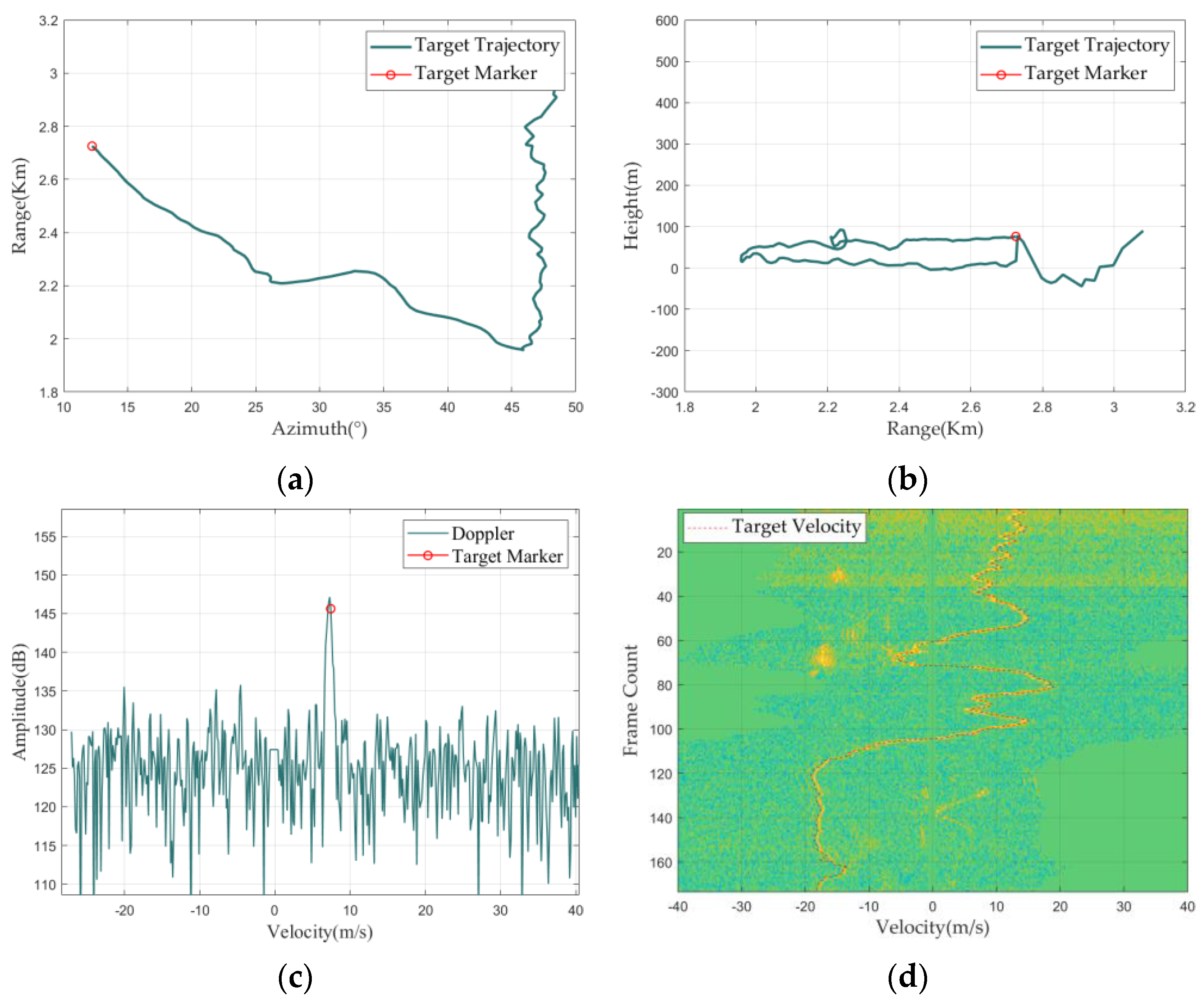
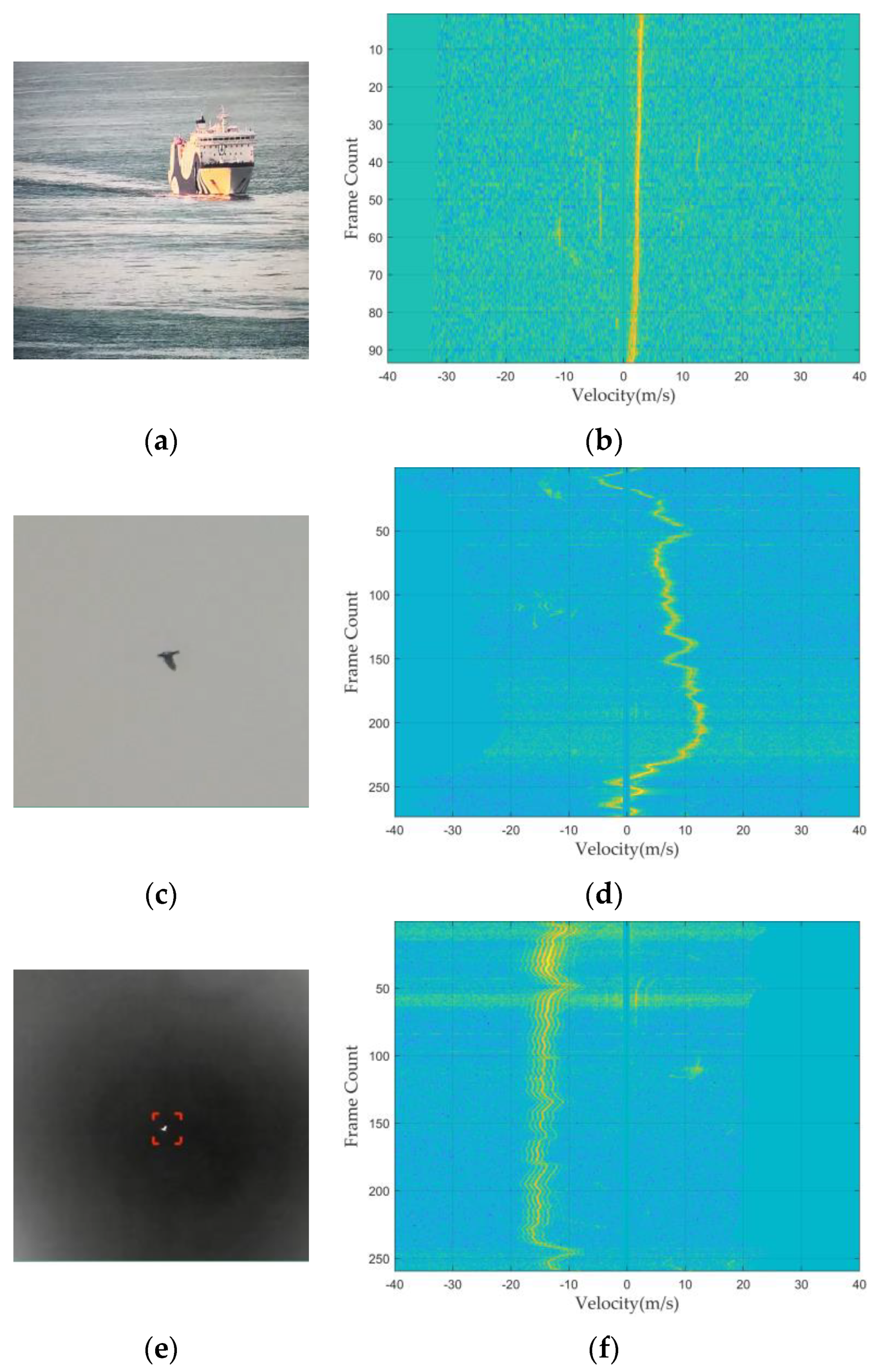
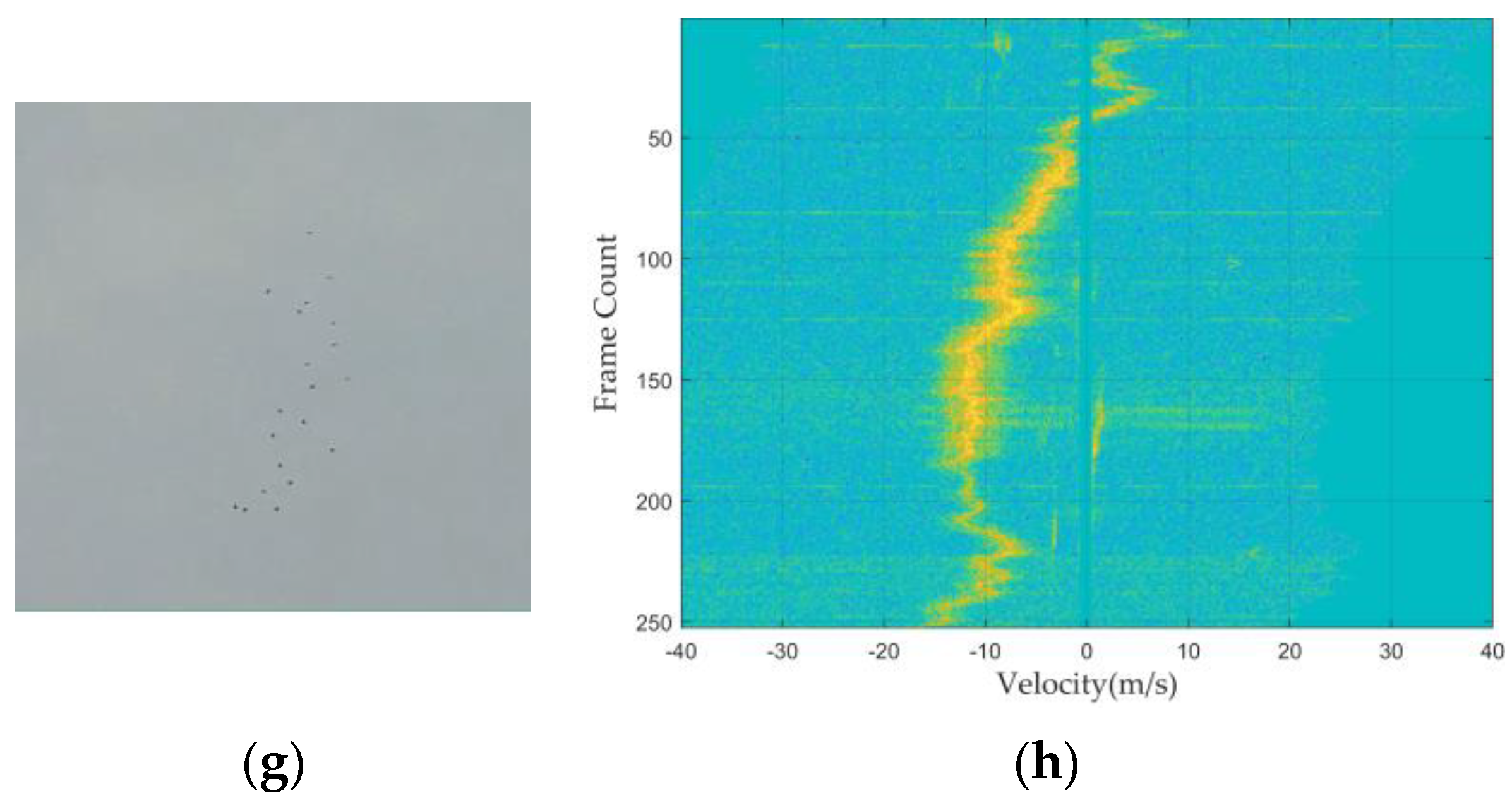

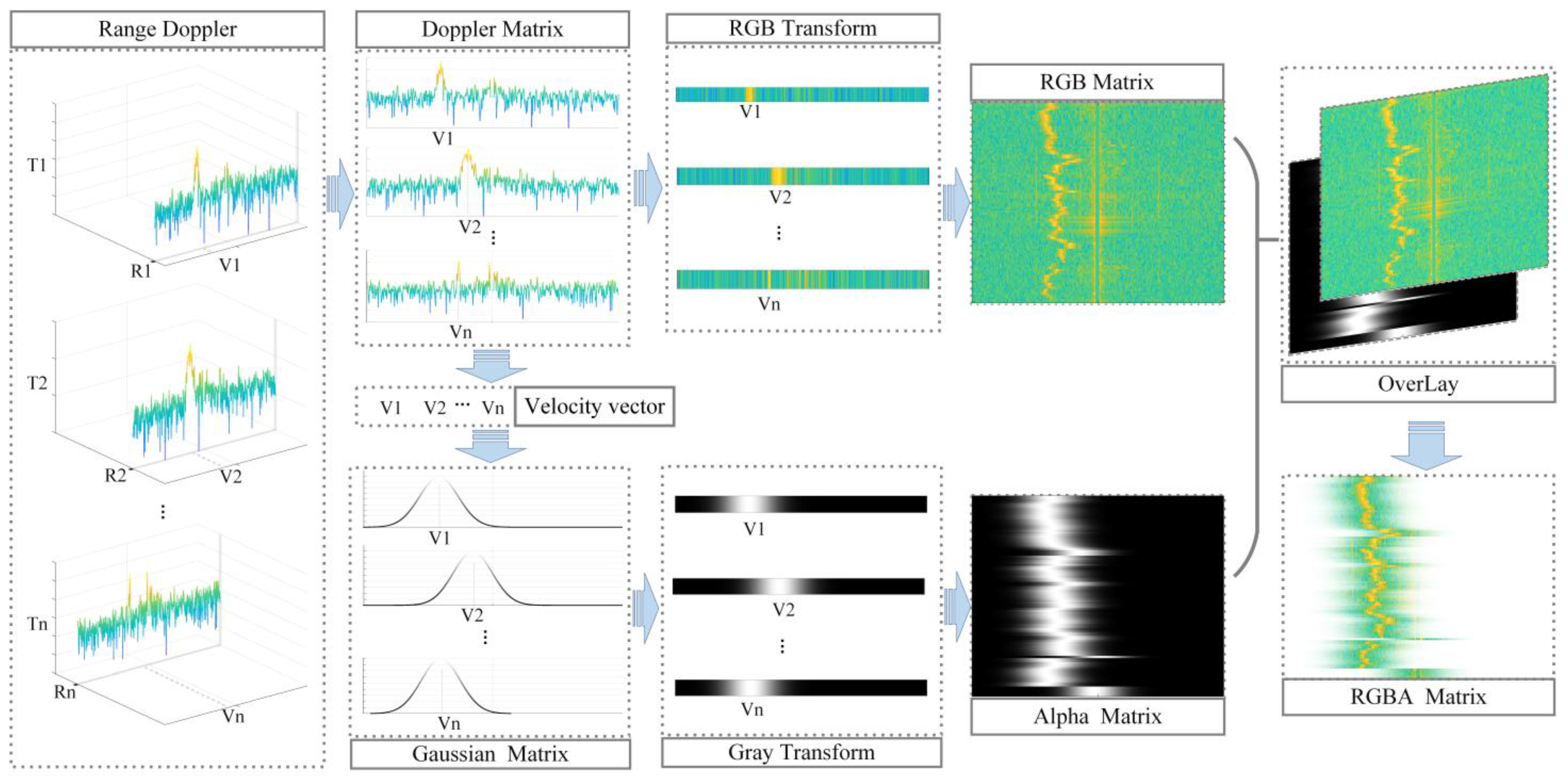
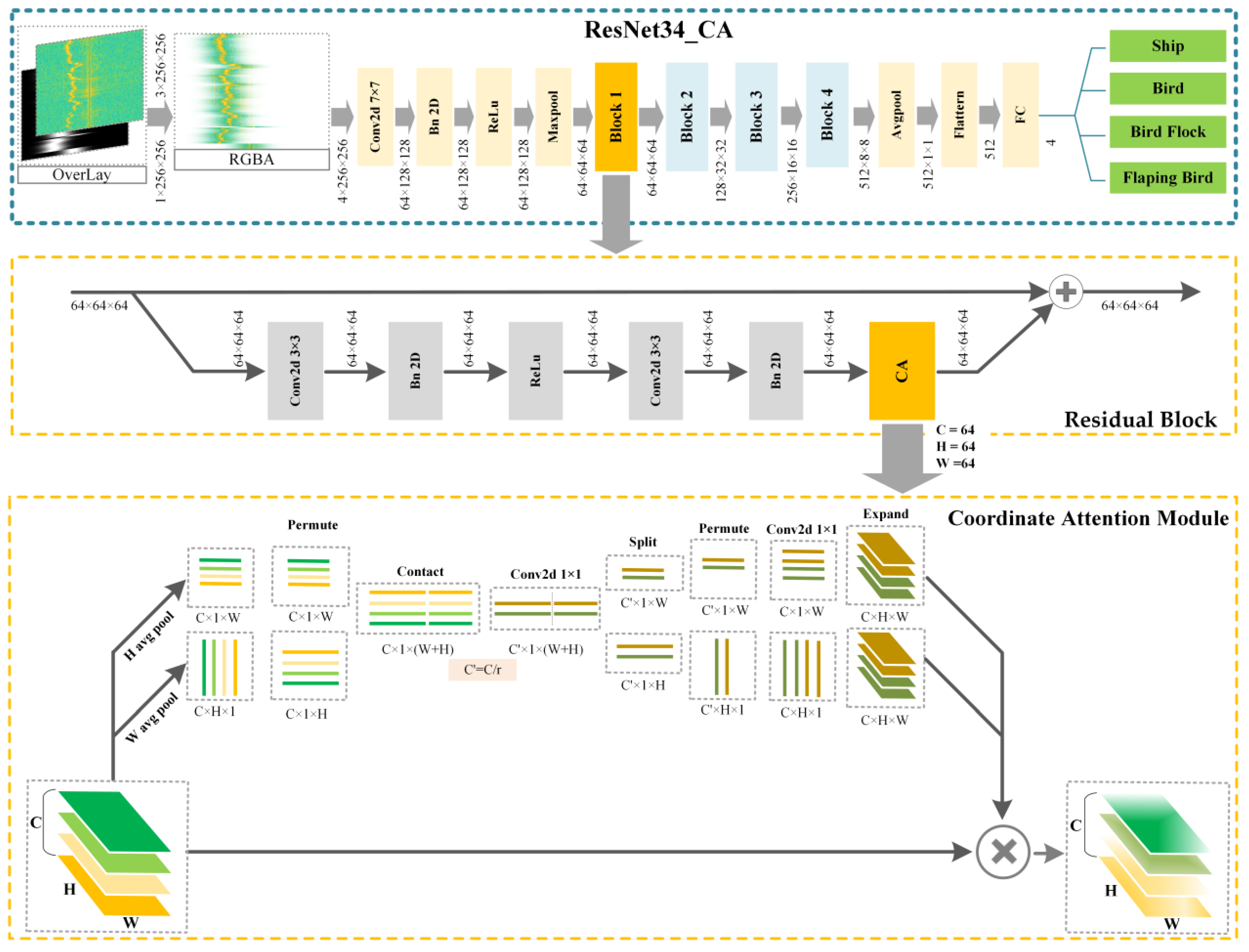

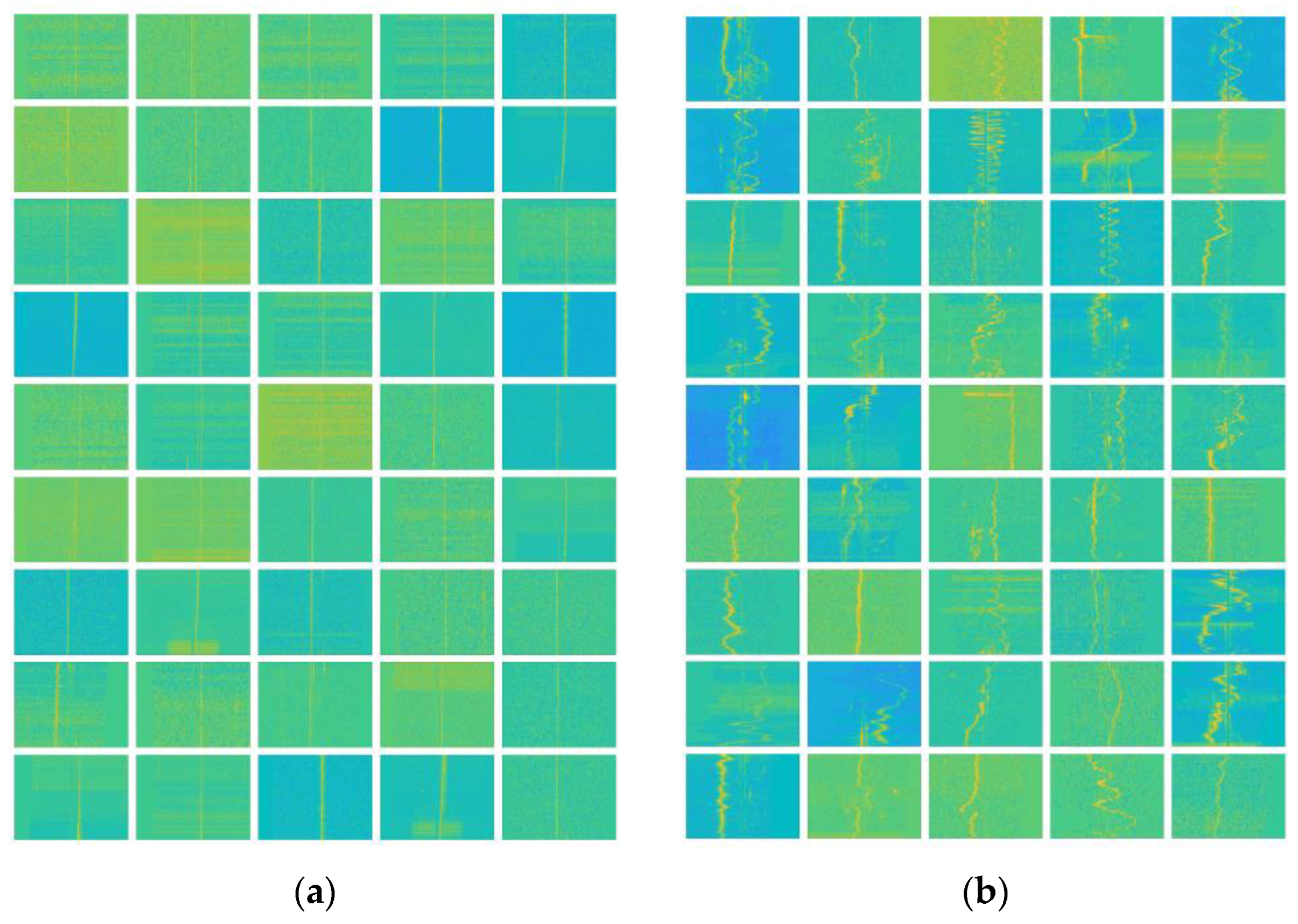
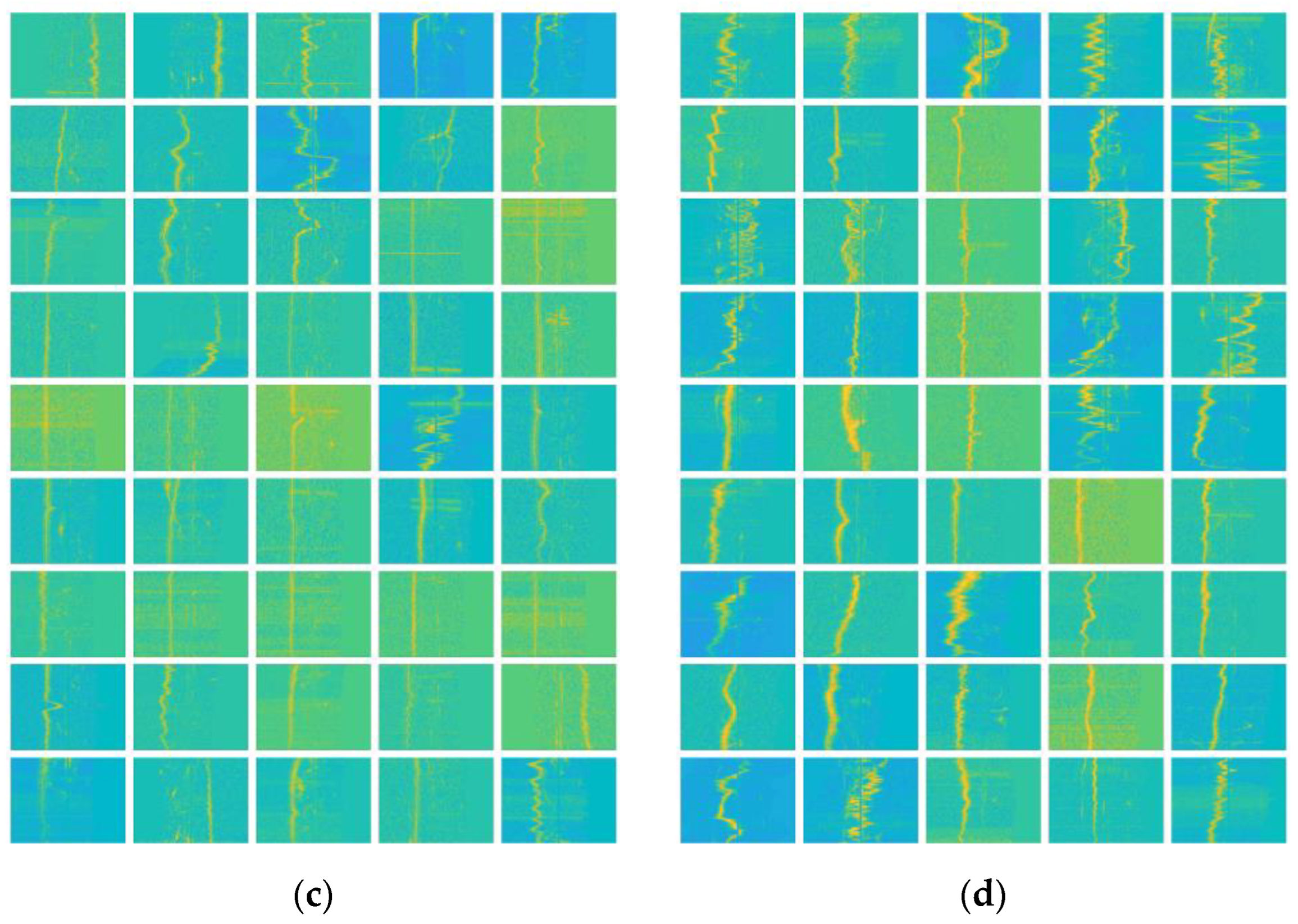
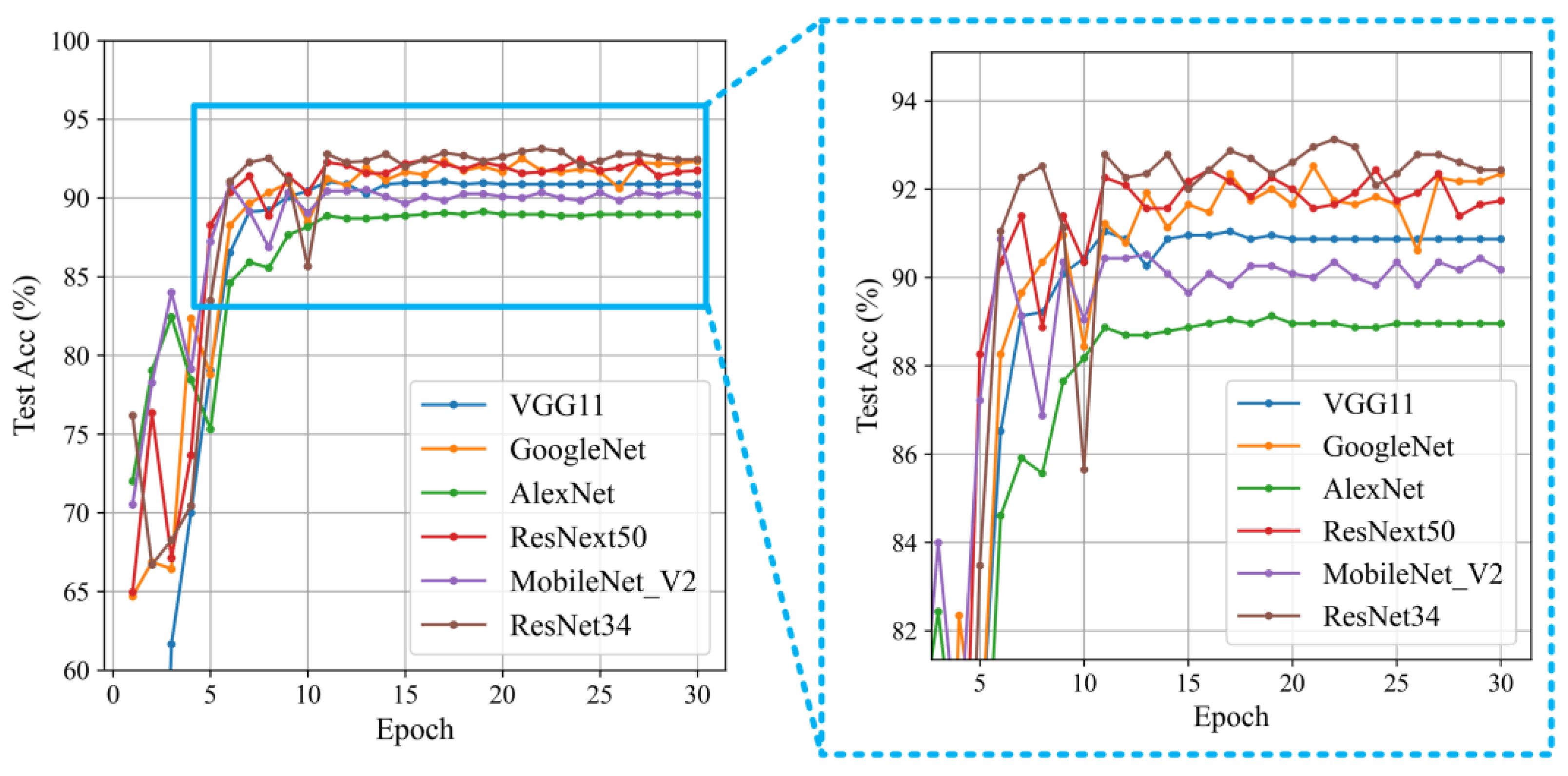
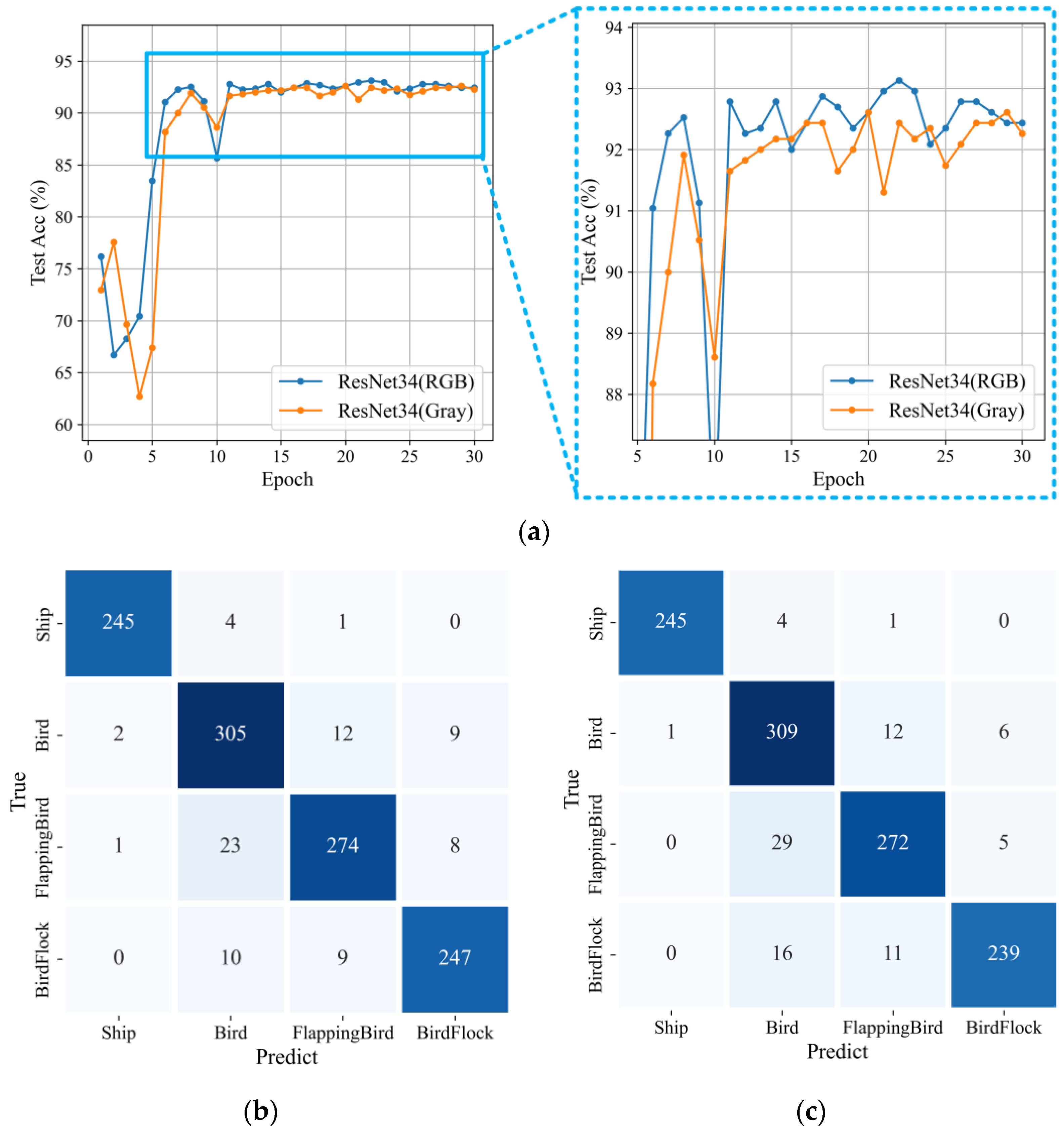
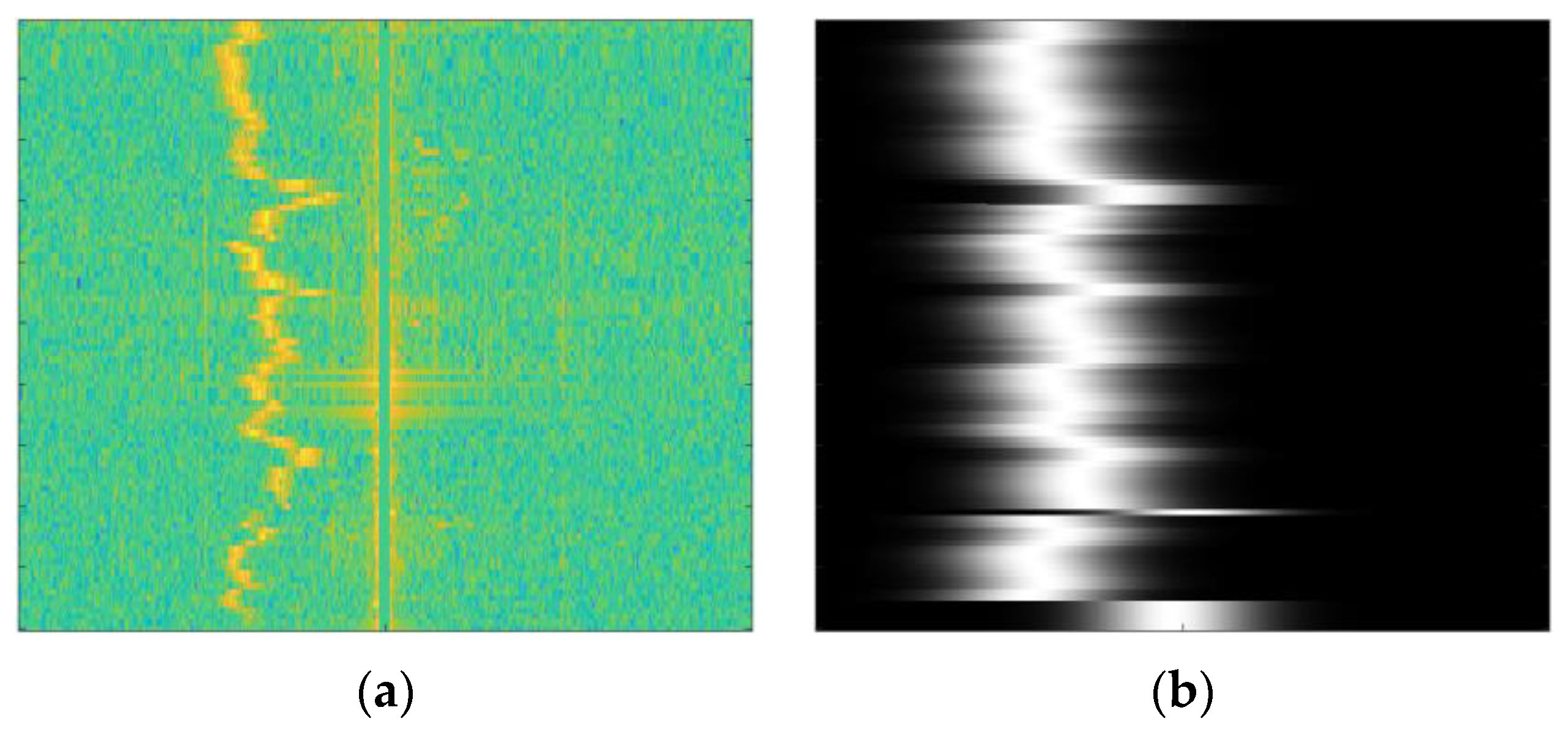
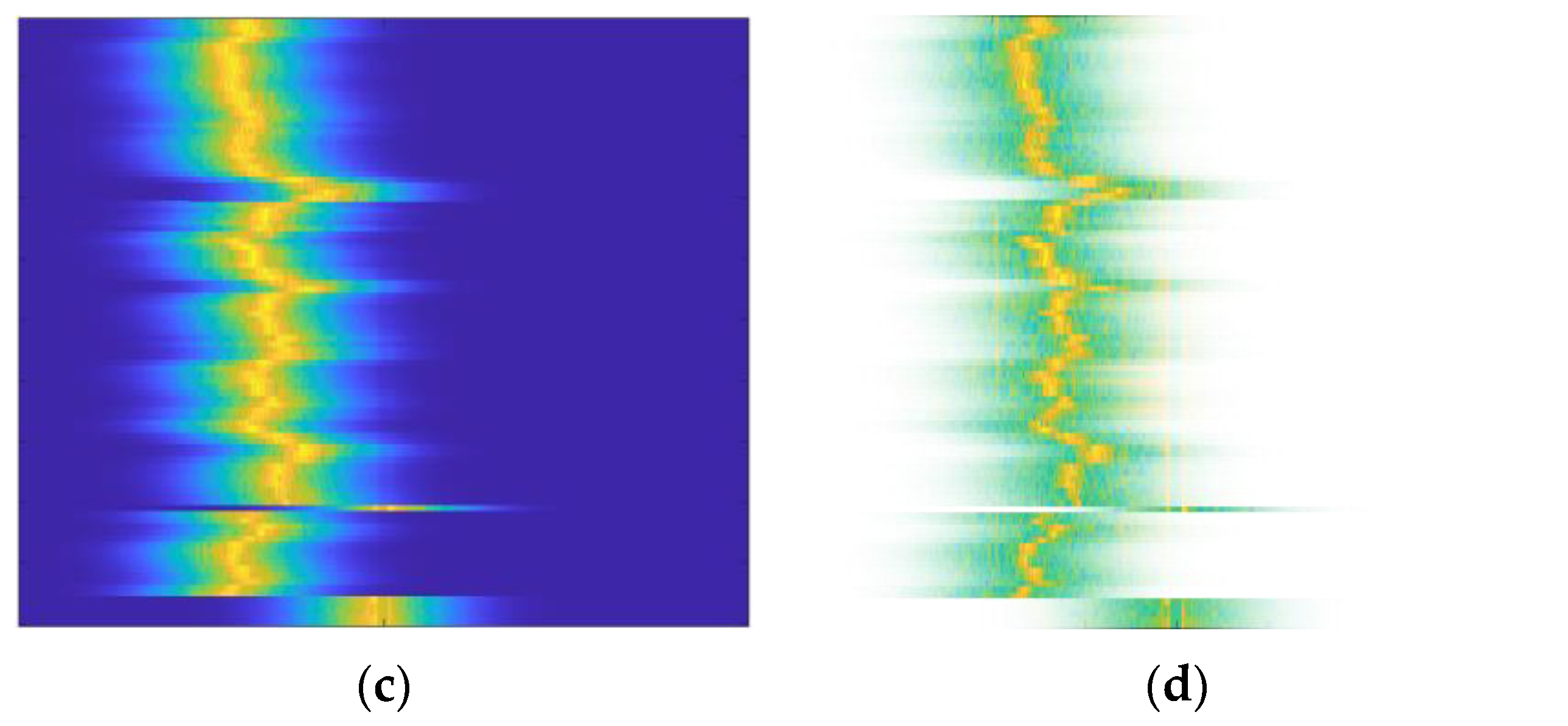
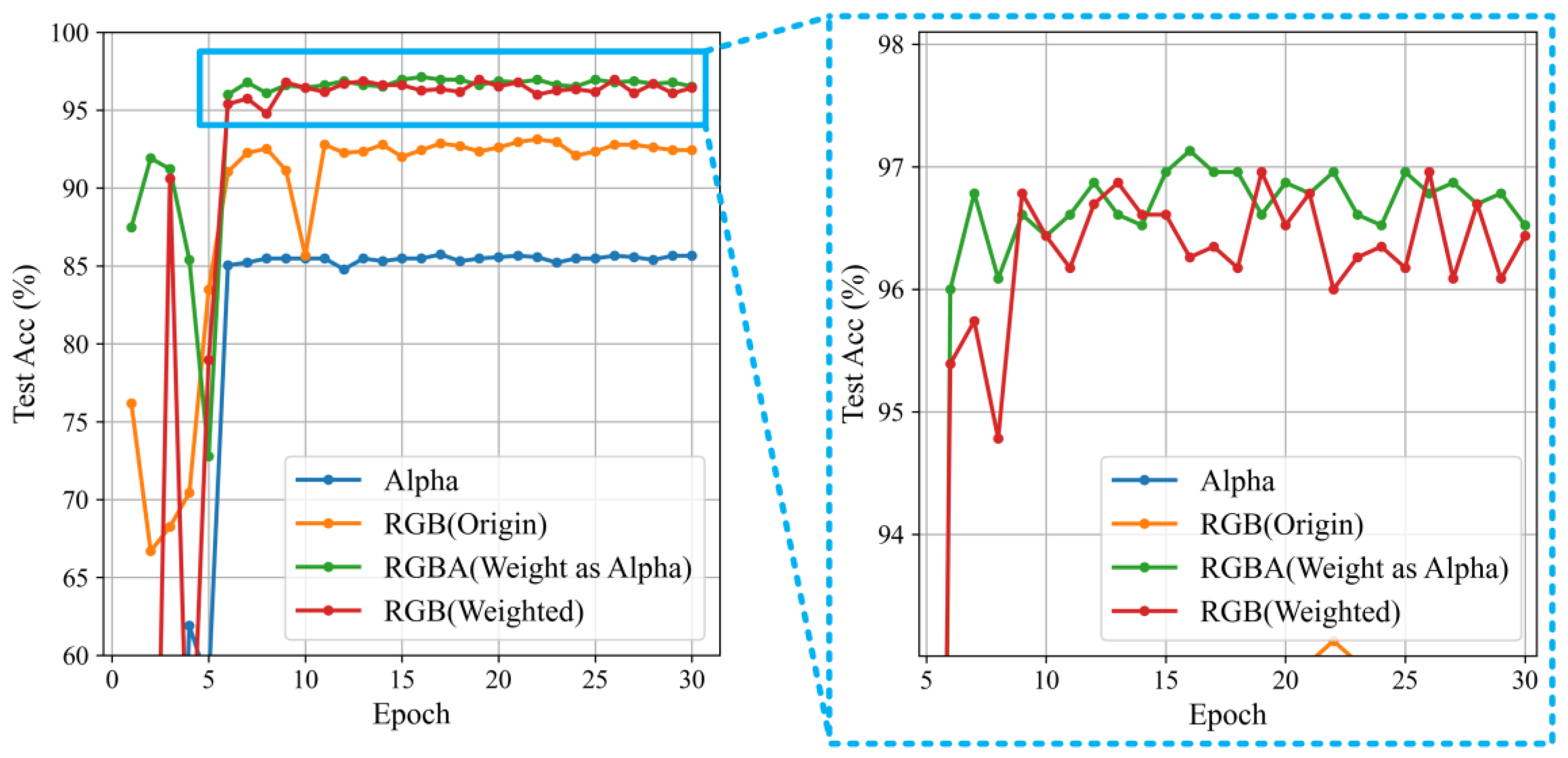
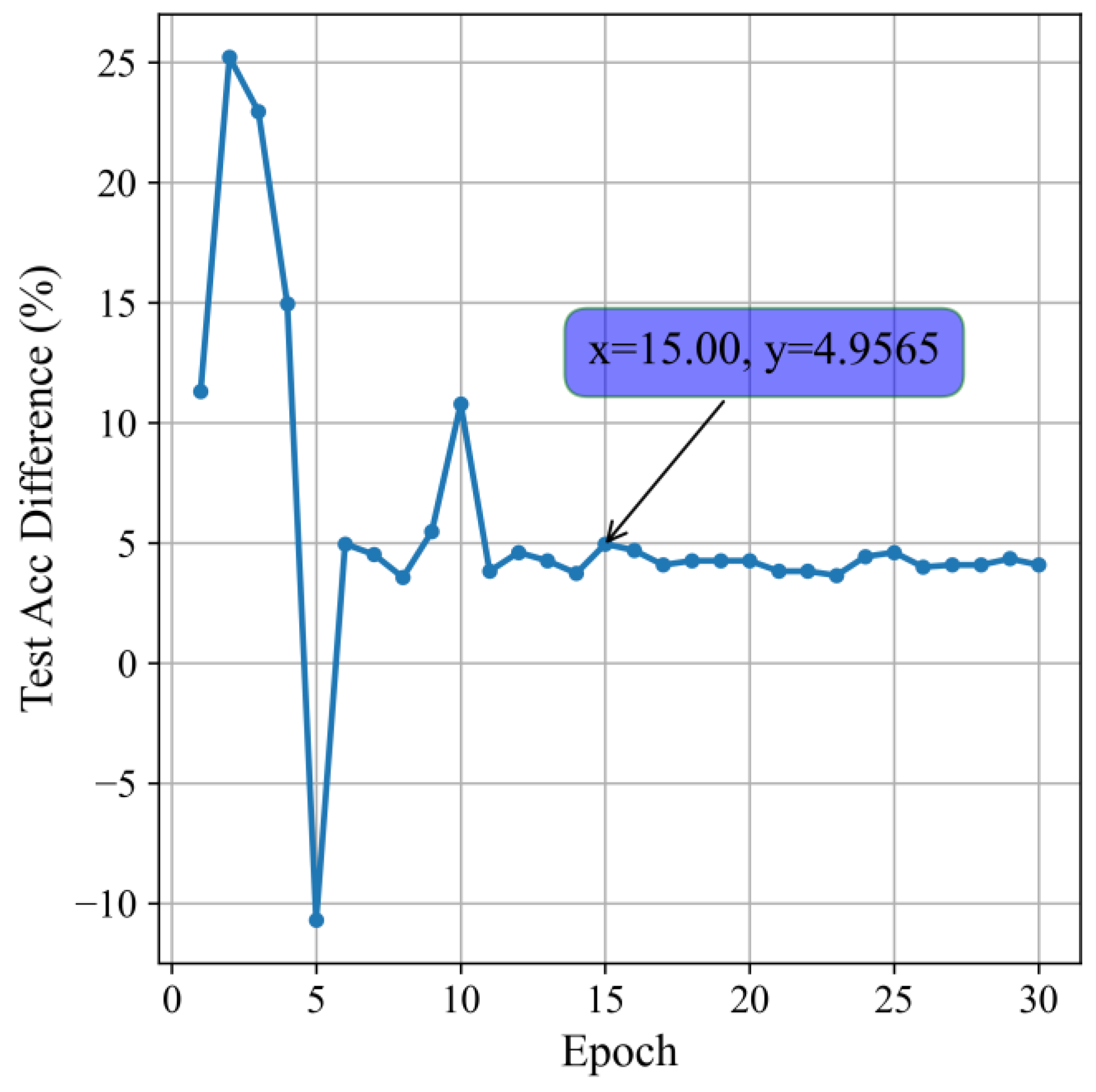
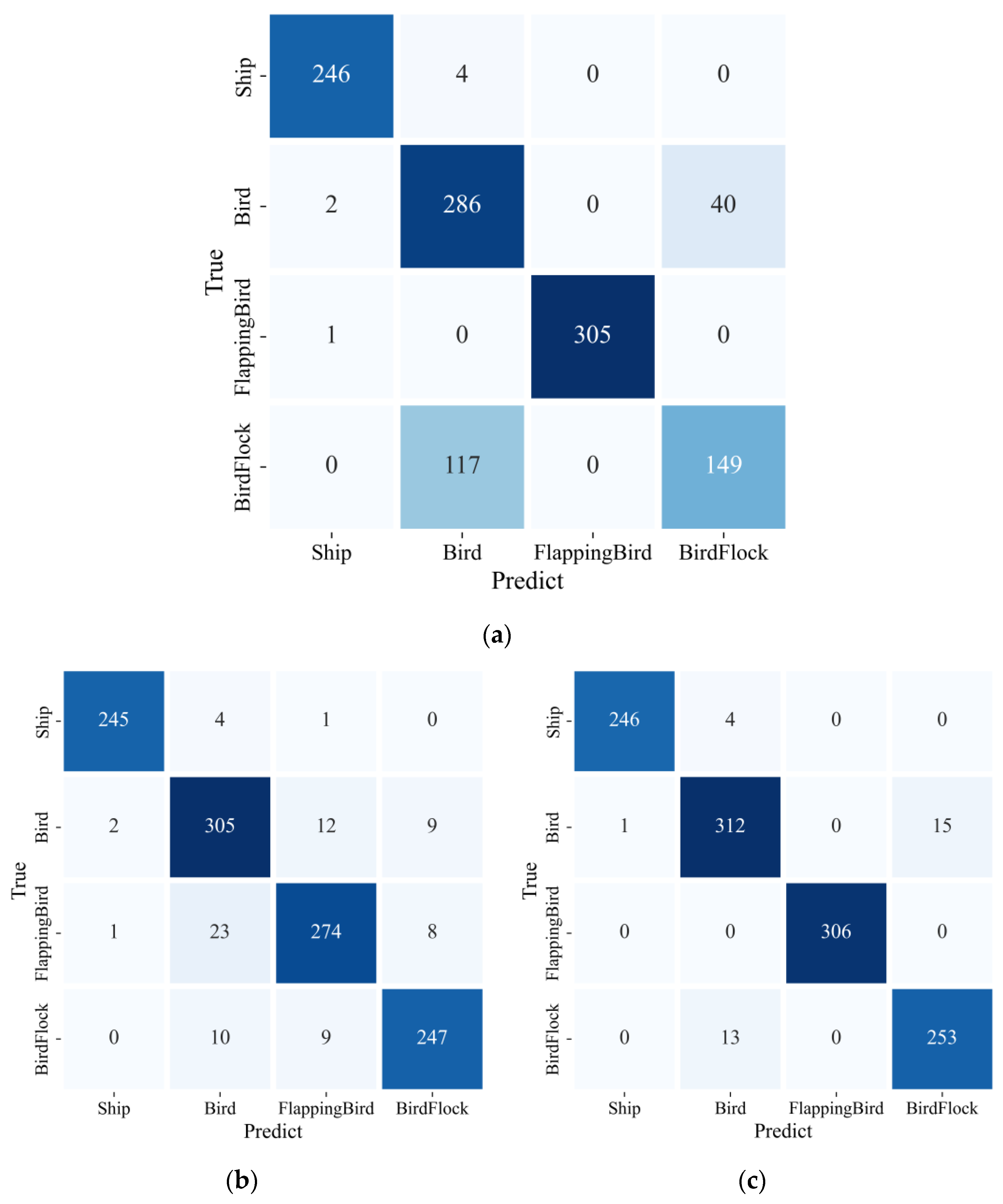
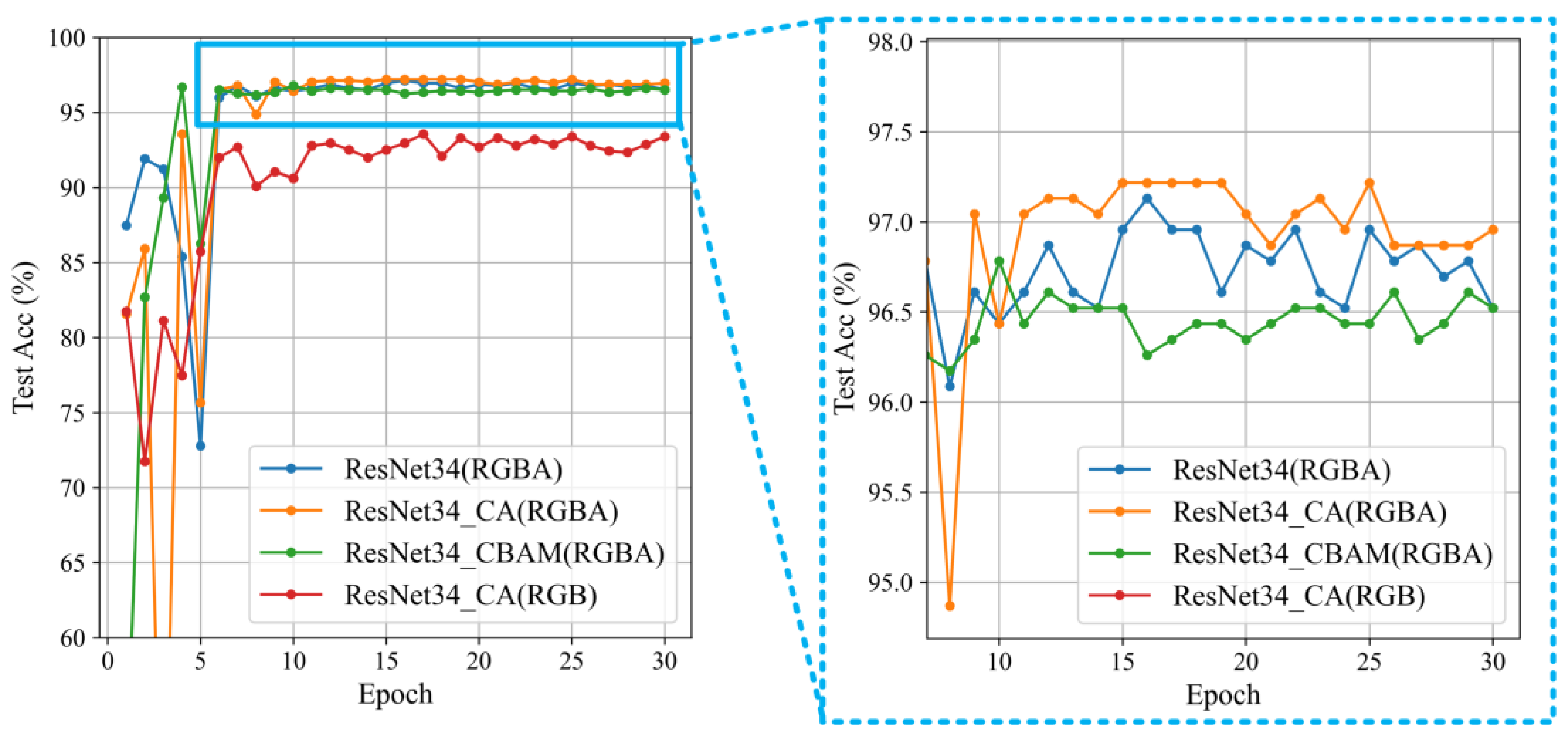
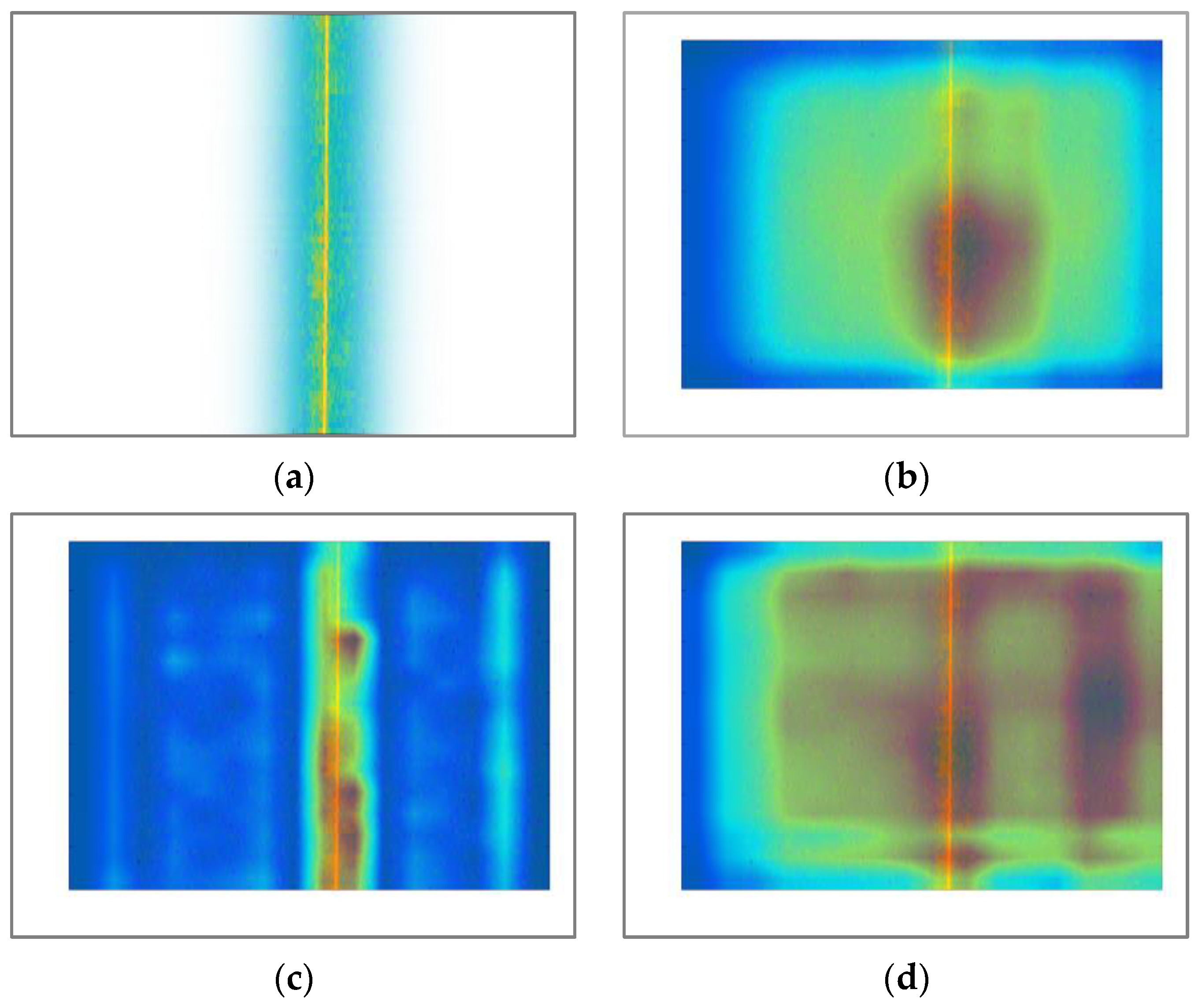
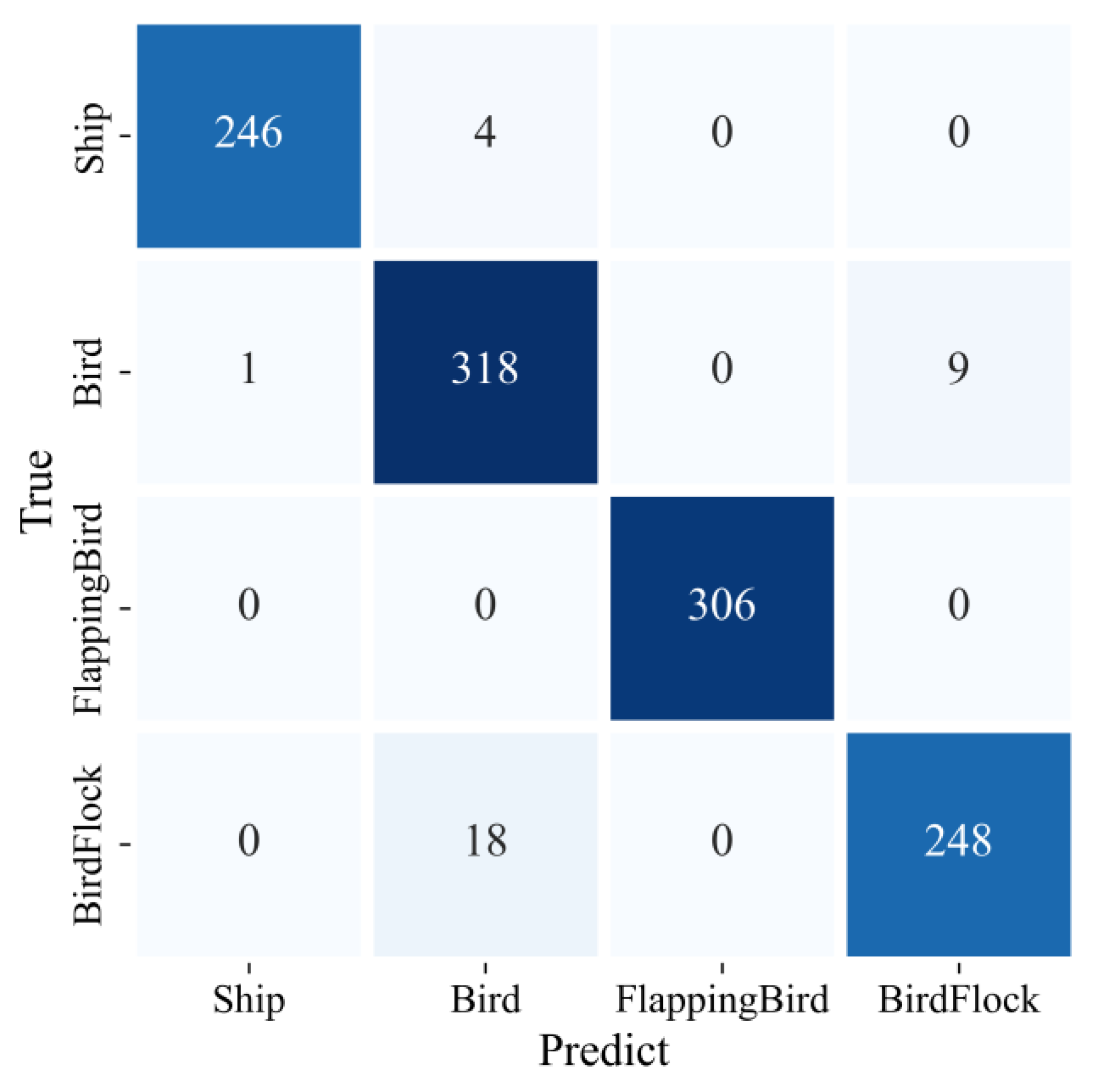
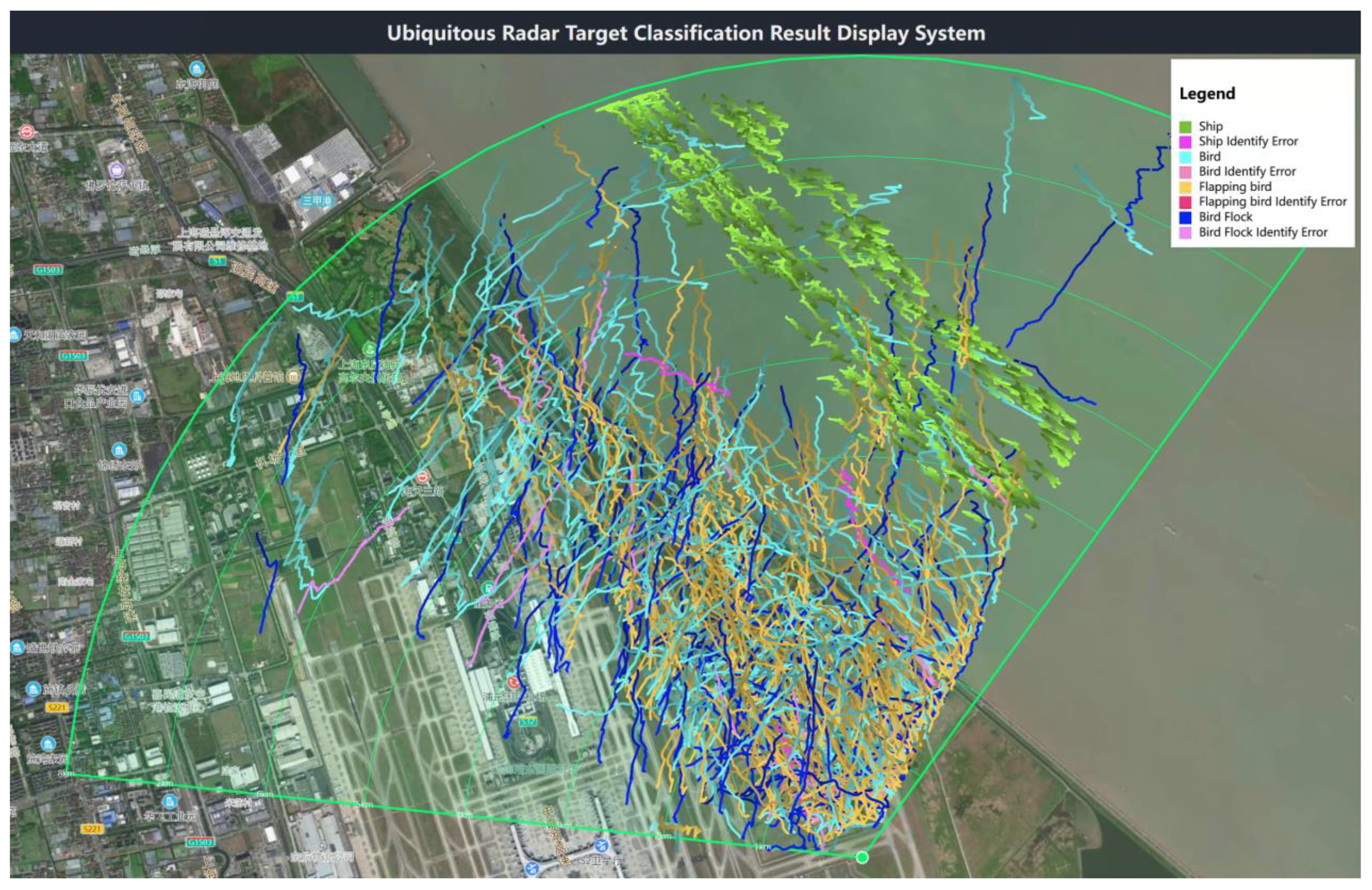
| Type | Training Set | Test Set | Total | Category Index |
|---|---|---|---|---|
| Ship | 824 | 250 | 1074 | 1 |
| Bird | 1121 | 328 | 1449 | 2 |
| Flapping bird | 1090 | 306 | 1396 | 3 |
| Bird flock | 705 | 266 | 971 | 4 |
| Type | Precision (%) | Recall (%) | F1_Score (%) | Accuracy (%) |
|---|---|---|---|---|
| VGG11 | 91.54 | 91.34 | 91.4 | 91.04 |
| GoogleNet | 93.06 | 92.69 | 92.85 | 92.52 |
| AlexNet | 89.79 | 89.61 | 89.65 | 89.13 |
| ResNext50 | 92.86 | 92.71 | 92.77 | 92.43 |
| MobileNet_V2 | 91.86 | 91 | 91.3 | 90.87 |
| ResNet34 | 93.52 | 93.35 | 93.42 | 93.13 |
| Type | Precision (%) | Recall (%) | F1_Score (%) | Accuracy (%) |
|---|---|---|---|---|
| RGB | 93.52 | 93.35 | 93.42 | 93.13 |
| Gray | 93.35 | 92.74 | 92.97 | 92.61 |
| Type | Precision (%) | Recall (%) | F1_Score (%) | Accuracy (%) |
|---|---|---|---|---|
| Alpha | 86.79 | 84.91 | 85.04 | 85.39 |
| RGBA (Origin) | 93.52 | 93.35 | 93.42 | 93.13 |
| RGBA (Weight as Alpha) | 97.21 | 97.16 | 97.18 | 97.13 |
| RGBA (Weighted) | 97.12 | 96.91 | 97.01 | 96.96 |
| Type | Precision (%) | Recall (%) | F1_Score (%) | Accuracy (%) |
|---|---|---|---|---|
| Resnet34 (RGBA) | 97.21 | 97.16 | 97.18 | 97.13 |
| Resnet34_CA (RGBA) | 97.41 | 97.15 | 97.26 | 97.22 |
| Resnet34_CBAM (RGBA) | 96.97 | 96.72 | 96.83 | 96.78 |
| Resnet34_CA (RGB) | 94.05 | 93.76 | 93.86 | 93.57 |
Disclaimer/Publisher’s Note: The statements, opinions and data contained in all publications are solely those of the individual author(s) and contributor(s) and not of MDPI and/or the editor(s). MDPI and/or the editor(s) disclaim responsibility for any injury to people or property resulting from any ideas, methods, instructions or products referred to in the content. |
© 2024 by the authors. Licensee MDPI, Basel, Switzerland. This article is an open access article distributed under the terms and conditions of the Creative Commons Attribution (CC BY) license (https://creativecommons.org/licenses/by/4.0/).
Share and Cite
Song, Q.; Huang, S.; Zhang, Y.; Chen, X.; Chen, Z.; Zhou, X.; Deng, Z. Radar Target Classification Using Enhanced Doppler Spectrograms with ResNet34_CA in Ubiquitous Radar. Remote Sens. 2024, 16, 2860. https://doi.org/10.3390/rs16152860
Song Q, Huang S, Zhang Y, Chen X, Chen Z, Zhou X, Deng Z. Radar Target Classification Using Enhanced Doppler Spectrograms with ResNet34_CA in Ubiquitous Radar. Remote Sensing. 2024; 16(15):2860. https://doi.org/10.3390/rs16152860
Chicago/Turabian StyleSong, Qiang, Shilin Huang, Yue Zhang, Xiaolong Chen, Zebin Chen, Xinyun Zhou, and Zhenmiao Deng. 2024. "Radar Target Classification Using Enhanced Doppler Spectrograms with ResNet34_CA in Ubiquitous Radar" Remote Sensing 16, no. 15: 2860. https://doi.org/10.3390/rs16152860
APA StyleSong, Q., Huang, S., Zhang, Y., Chen, X., Chen, Z., Zhou, X., & Deng, Z. (2024). Radar Target Classification Using Enhanced Doppler Spectrograms with ResNet34_CA in Ubiquitous Radar. Remote Sensing, 16(15), 2860. https://doi.org/10.3390/rs16152860







